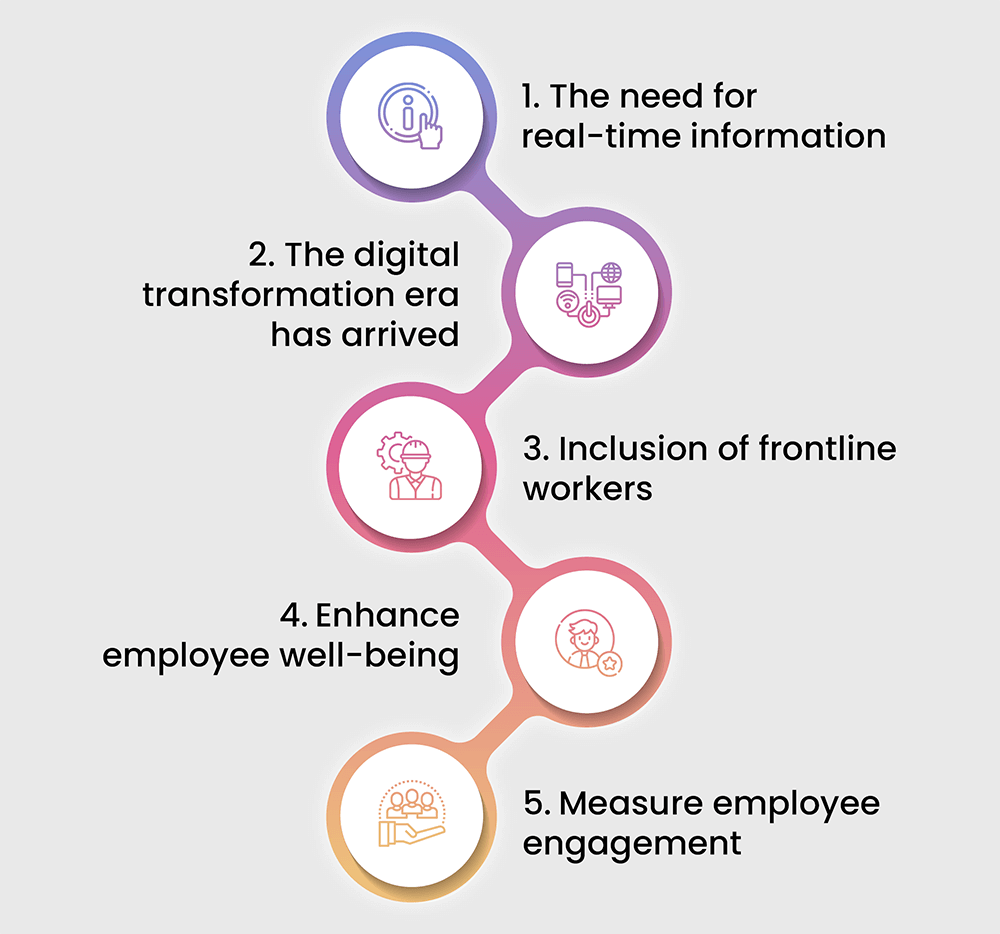- Home
- Blog
- Digital Workplace
- Internal communications trends for 2022
29 Apr

Internal communications trends for 2022
Every year, new problems and methods of working emerge. Many issues and difficulties have arisen due to the Covid-19 pandemic. As a result of the unprecedented disruptions and dispersion of workforces, the focus has turned to corporate internal communications. Suddenly, every employee turned to internal communications for real-time alerts, policy shifts, and notifications from executive leadership that would offer support during difficult times. The internal communications tools that have been neglected and undervalued for too long now see some much-deserved recognition.
Today’s businesses are operating in a more dynamic environment- workplace demographics are shifting, remote working is becoming the trend, the modern workplace is becoming more sophisticated, and the need for communication is growing more important than ever. The teams must move beyond and beyond to ensure their communication strategy continues to engage.
How important is internal communication?
Internal communications have always meant different things to different organisations, from producing and sharing the top business news and messages on behalf of management to facilitating simple two-way communication among the employees through the most relevant platforms. This sort of communication keeps the employees informed and help them perform their job better. Updating the workforce about the business at regular intervals will develop a sense of transparency within the organisation. An excellent internal communication tool will nurture the company culture and increases employee engagement.
The primary role of internal communications is to make your organization’s culture manifest. If that is implemented well, the internal communication strategy will bring the company culture to life. As the announcements, articles, news, and CEO messages will play a vital role in deriving how the employees interpret the cultural environment of an organization.
As per IBM, around 72% of employees fail to understand their company strategy.
This shows that when employees are not clear about what’s happening in their organization, they cannot have an understanding of the business overall.
Internal communication trends that every organization should have

The IC team needs to strategise in a way that should change the face of the business.
1. The need for real-time information:
Time waits for none, so we need to increase our pace or change the approach to achieve outstanding internal communication. Earlier, it was acceptable to send the updated company information over email and wait for it to be read by the employees in the organisation for a week is no longer a choice now. It is very crucial to ensure the information is delivered instantly.
In 2022, instant messaging will be one of the most important forms of internal communication. An intranet can be the platform to deliver real-time notifications, pop-up messages, and instant messaging. Employees can access intranets through their laptops or any other mobile device. Pop-up messages will help the remote/hybrid workforce access critical information and ensure they do not miss the notification. This makes it possible to distribute real-time messages across the company, meaning that everyone gets the same message simultaneously.
2. The digital transformation era has arrived
The disruptions of 2020-21 are the powerful accelerators that led to the emergence of digital business transformation. As per Dell-In reaction to the current scenario, eight out of ten businesses have accelerated a few parts of their digital transformation, and nearly 80% of organisations are reinventing their business model. The traditional methods of internal communication like printed newsletters, in-person meetings, and conferences are no longer feasible. It’s been apparent that businesses need internal communication channels that can instantly reach employees, no matter where they are. Communication needs to be measurable to understand if the recipient receives it. Employees must be reachable at all hours in the case of an emergency, no matter where they are.
Going digital is the key to connecting the dispersed workforce. It facilitates the employees to connect and communicate effectively and immediately. Communicating digitally will provide an opportunity to capture employees’ attention quickly and accurately monitor the impact of the communications.
3. Inclusion of frontline workers
Desk-based workers are constantly updated about their company policies, news, and much more when compared to desk-less employees. Improving frontline engagement has been non-negotiable. These workers are now at the top of the priority list. Despite the pandemic, the frontline staff kept it running. According to a study, 87% of leaders believe that organisation would be more successful when frontline workers are empowered to make crucial decisions.
Frontline workers need access to communication tools that connect them easily and instantly. Internal communication tools with the mobile-ready feature can help these employees. They can quickly go through the notifications posted by the management and stay updated.
4. Enhance employee well-being
Employee health and well-being are often undervalued the most. The majority of the employees are disturbed and have many health and mental issues in this disrupted situation. Anxiety, and stress is the real problem that needs to be addressed with utmost care.
It is important to know how your employees are feeling. Collecting feedback and valuing employees’ ideas regularly will keep them happy and motivated to achieve company goals. An intranet with feedback channels, discussion rooms, virtual water cooler sessions will be a rescue to the employees feeling stressed out.
5. Measure employee engagement
Regular evaluation needs to be done to maintain internal communication tools. Teams who aren’t measuring the effectiveness of the tool are in danger. The executives need to know the employee engagement and productivity increase around the internal communication tool to understand the content relevancy and update it accordingly.
Through SEEK, Acuvate’s SharePoint analytics tool- Measure and Analyse your intranet adoption. It keeps track of the intranet content’s relevancy and provides engagement reports to analyse the engagement patterns and bring the most relevant content, making the intranet most effective and engaging.
Conclusion
The covid-19 crisis is very far from over. Companies need to plan bold strategies for effective internal communication. Unite your organisation with an intranet with all the features to feed the dispersed workforce working round the clock.
If you want to level up your communication strategy with the next-gen intranet, explore Mesh!
Poonam Chug is AVP - SaaS Strategy & Business. She has worked in various areas, right from designing and executing sales & account management strategies to reengineering digital workplace solutions. With her determined focus on our mission and progressive approach, she has achieved customer delight in the space of AI, Knowledge Mining, Content & Collaboration, Virtual Assistants, RPA and more. Backed with a deep understanding of customer needs and technology, she leads the SaaS business unit with an upshot of maximizing revenue while ensuring customer satisfaction.





Poonam Chug